While there are many dangers involved in surfing, it’s not the most extreme sport — think mountaineering, base jumping, boxing, or rugby. So yes, there are risks, but there’s also hope! In this article, we will uncover not only what the dangers of surfing are, but how we can stay safe, and why experienced surfers keep going back for more.
My name is Carly Stoenner, and I myself am a life-long surfer from Southern California and have never suffered a surf-related injury (knock on wood). I use shortboards, longboards, funboards, and foam boards and began driving to the beach by myself as soon as I turned 16.
Since then, I was the Lead Surf Instructor for UCLA Marina Aquatic Center, and a Lead Guide for Rustic Pathways Surf and Service Costa Rican programs, ensuring the safety of hundreds and hundreds of students (of all ages) throughout my lifetime. In addition to surf instruction I’ve also led ocean classes for sailing, kayaking, paddle-boarding, and even windsurfing, requiring a deep understanding of how to keep my clients safe on the water.
Here at Bodhi Surf + Yoga, we pride ourselves on teaching you the tools to keep yourself safe out in the water too. Finding a reputable surf school to teach you the safety essentials truly makes this a safer sport for everyone.
So let’s discuss what makes the ocean dangerous, what wildlife threats there are, and what tips and skills do we need in order to play safely. Finally, we will determine if surfing really is worth the risk.
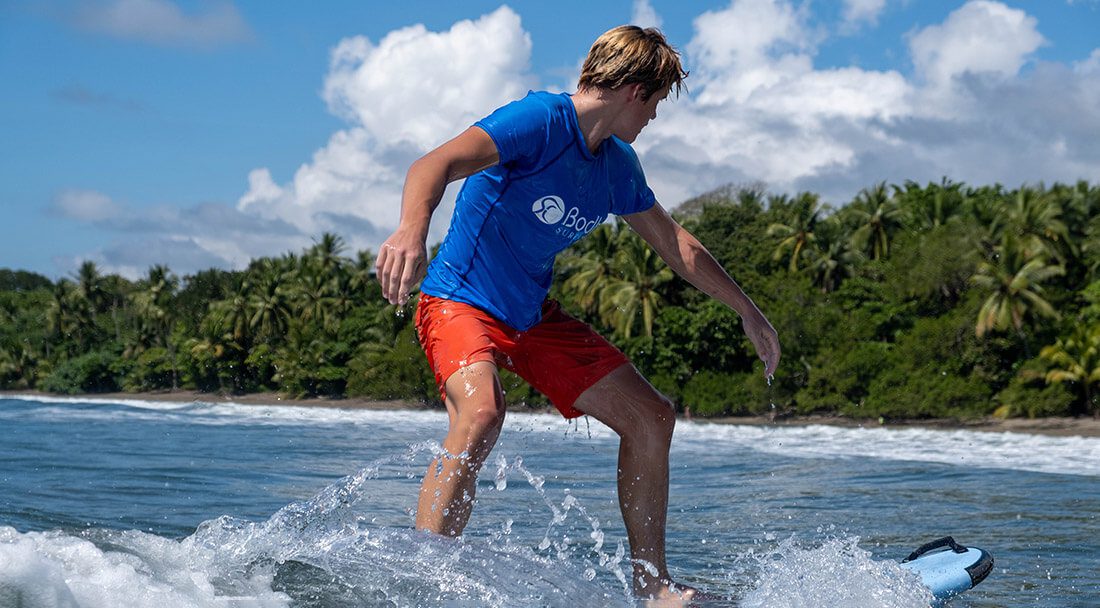
Dangers to consider when surfing
Ocean threats
Is the ocean dangerous? Yes! The ocean can be a dangerous place for beginners due to constantly evolving wave conditions.
For example, a beginner surfer might go to the same beach two days in a row, and on the first day, they find waves perfectly suitable for their skill level. The next day, however, they might find howling winds, waves twice the size, and the tide too low, exposing rocks that were underwater the day prior.
The ocean is an environment that is constantly changing, so learning how to assess the surf conditions and learning to read a surf report is crucial to staying safe.
Surfers can easily look up this information on reliable surf report websites such as Magic Seaweed, but the conditions are always in flux, so it’s important to learn to “read” the ocean conditions upon arriving at the beach.
At Bodhi Surf + Yoga, we begin each surf lesson with a detailed explanation of the key components of a “surf report”: wave size, tide, weather, and potential hazards.
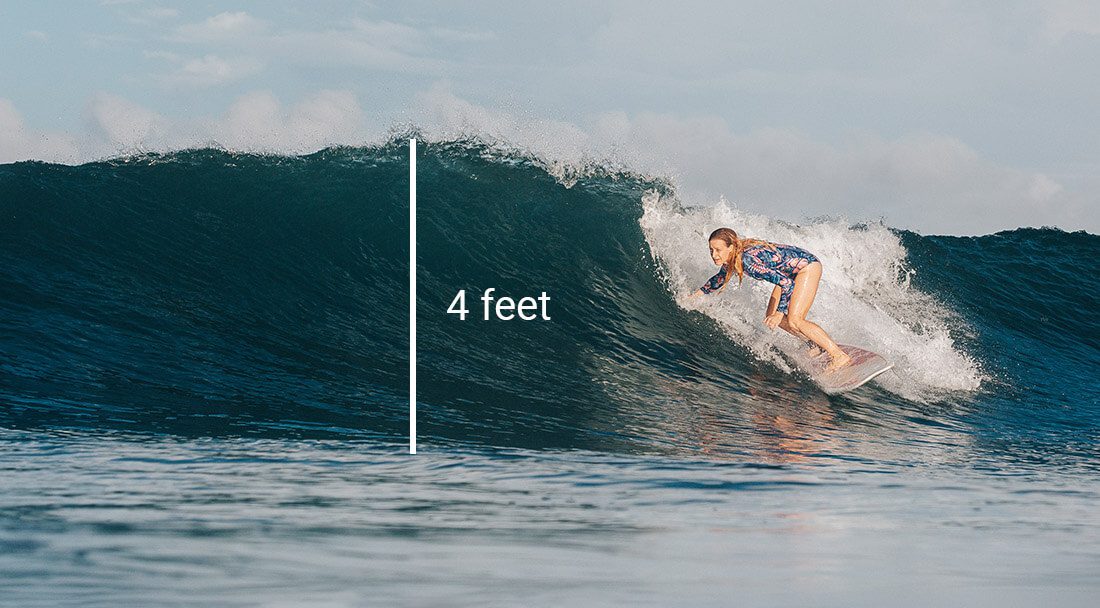
So, what to look for:
Wave size
- Whitewater waves are well-suited for any skill level and are great for practicing wave selection, board control, turning, and paddling.
- 1-3 foot waves are perfect for beginners learning to catch waves as they “break” or transition from green to white.
- 2-4 foot waves are acceptable for intermediate surfers who have strong board control skills and the proper tools to paddle past the breaking waves.
- 4-8 foot or bigger waves are best left for advanced surfers who know about timing sets, avoiding the “impact zone” (the place where the waves break), and surf etiquette.
- 8 ft. + are BIG waves and only highly experienced folk should enter the water.
Tide
- Beginners should look for sloping waves that are breaking or crashing slowly, usually at higher tides.
- Low tides create conditions where the waves break rapidly with more force over shallower water (i.e. avoid low tide if you are a beginner).
- Generally speaking, most surfers prefer a mid-tide at most surf spots — neither too high nor too low).
Weather
- Lightning: Always get out of the water if you see lightning.
- Sun: Use protective surf clothing, including rash guards, leggings, and hats. This will reduce the risk of skin cancer. Sunscreen that is REEF-SAFE is acceptable for the face but must be reapplied after an hour in the water.
- Wind: Light offshore winds (wind that moves from the land towards the ocean) are preferable, or even better, no wind. Light wind and breezes are safe, but be wary of wind that is over 10 knots (18 + kph) (strong enough to blow your hat off), as the strong wind has the possibility to blow surfboards and other objects into the air and generally makes paddling more difficult due to wind waves.
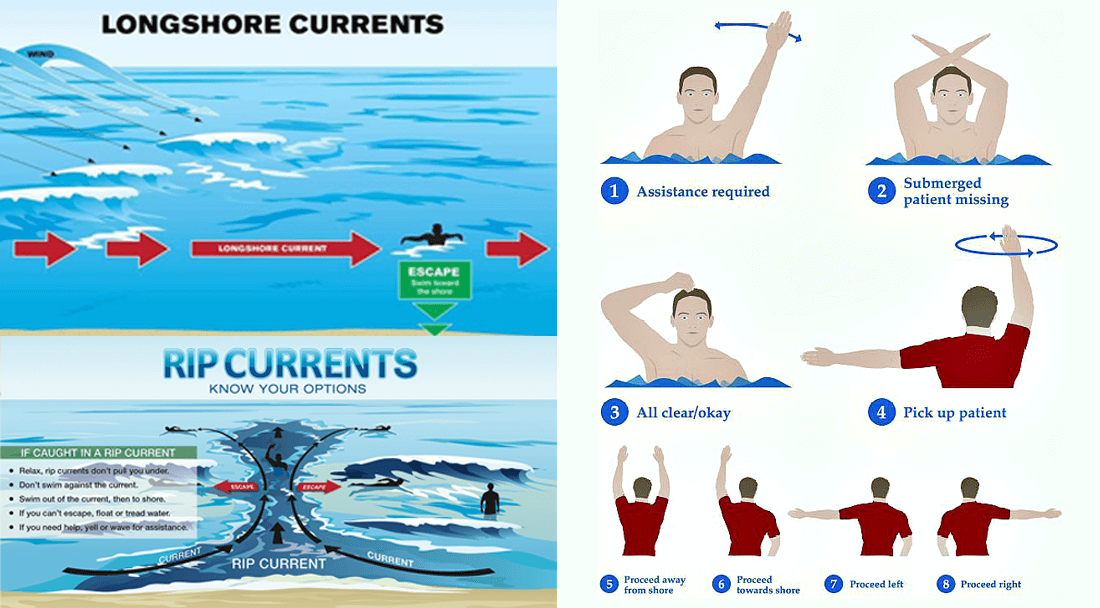
Rip currents
- Rip currents (sometimes mistakenly called rip tides) form in the wave zone, but having a surfboard actually makes surfers safer. To escape a rip current where the water is flowing out to the ocean, paddle to the left or right, parallel to the beach, and perpendicular to the current.
- If the current is moving north-south (longshore), paddle towards the beach moving with the current. Never paddle directly against the current.
- If you are in a current and feeling tired, just relax on your board and let it take you past the breaking waves to deep water. From there you can signal for help.
- Use hand signals to get help. One or two arms waving overhead is a sign that you need assistance. Touching your fist to your head is a sign to lifeguards that you are O.K.
- Learning to bodysurf will increase your confidence in the water in case you do lose your surfboard and get caught in a current.
Other potential surf hazards
- Underwater rocks
- Marine life (more below)
- Beachgoers such as swimmers, other surfers, or stand-up paddlers
- Piers, jetties, or other man-made structures
Always ask locals about potential hazards as they can be hard to spot at first glance. One simple way to avoid hazards is to simply keep away from rocks, other surfers, swimmers, and structures. Choose sandy beaches where surfers can easily spread out.
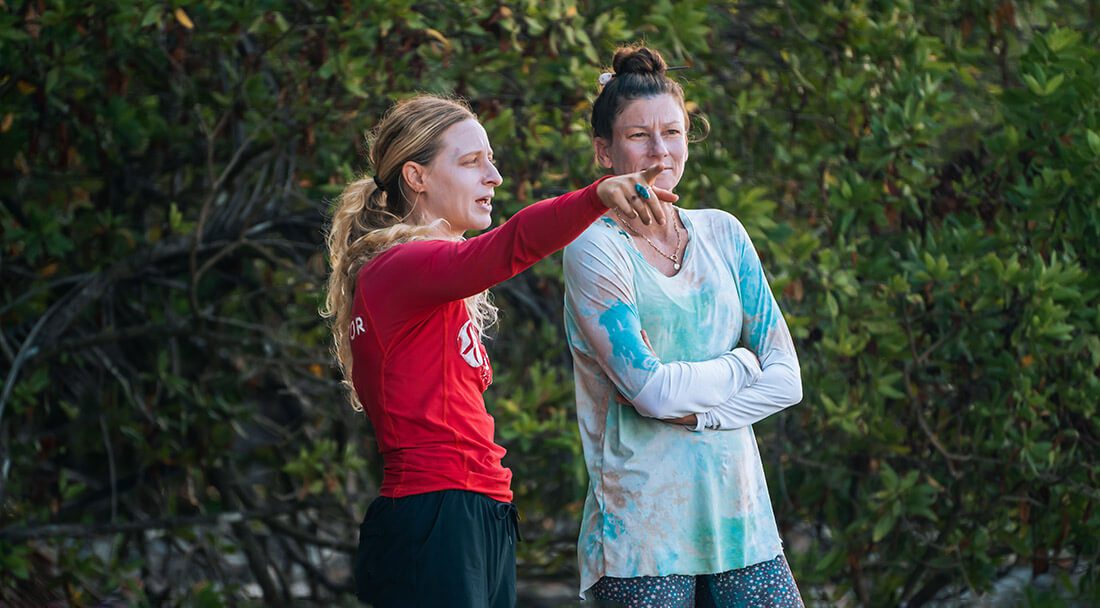
Wildlife threats while surfing
Many people ask me, “but aren’t you scared of sharks?” This fear of what is swimming underneath is a common one. (Truth be told, I think of crocodiles more than sharks).
Even advanced and professional surfers have to be aware of dangerous wildlife, as there are a few types of wildlife that can pose a very real risk to surfers and beach-goers.
- Sharks get a lot of attention in the news which is why they’re on the forefront of our imaginations. It’s always best to ask locals at your home beach if there are regional shark threats since they frequent some beaches more than others (Australia making the top of the list). But, in the last 400 years in Costa Rica, there have been only 12 shark attacks (6 of which were fatal). Here, shark attacks are extremely rare.
- Crocodiles live in the tropics and are mostly fresh-water species (they live in rivers) but are also known to frequent some beaches. Crocodile attacks are rare but not unheard of. It’s best to surf and swim away from river mouths, estuaries, and mangroves. If you want to cross a river to get to a surf spot on the other side, do not paddle accross. Many surf spots have boats that will ferry you to the other side.
- Stingrays can be found on many beaches worldwide as they feed on the ocean floor, and will actually sting when stepped on. It’s best to “shuffle” your feet along the ocean ground instead of taking big steps since the vibrations created by your feet will scare them away. Stingray stings are painful but treatment is easy (a bucket of hot, salty water reduces the pain and stops the venom from spreading).
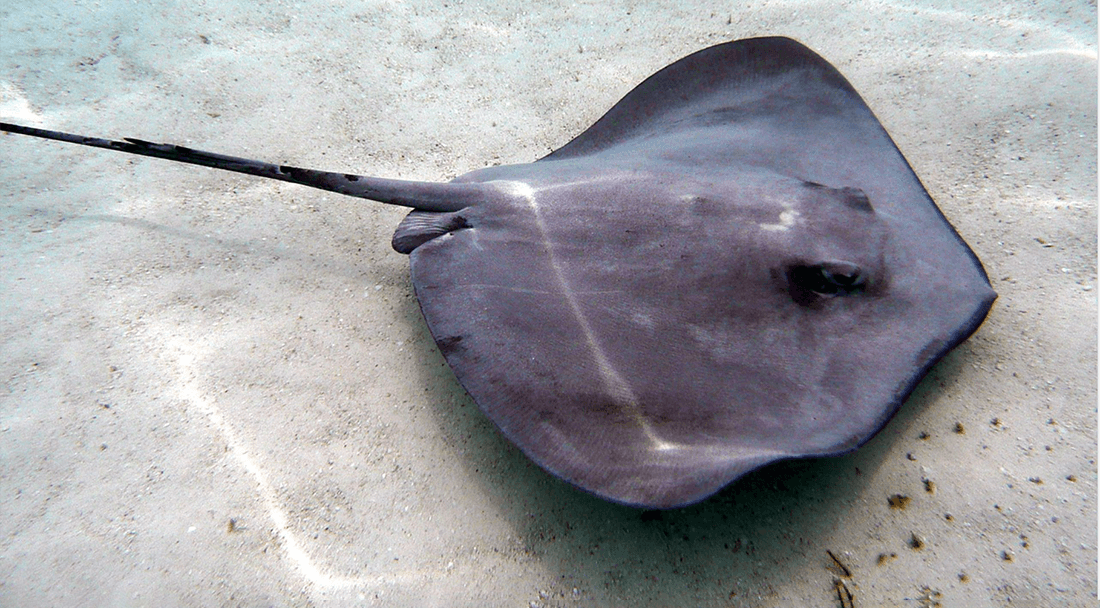
Common surf injuries and tips to avoid them
Like any “extreme sport,” injuries will be common if you do not know how to be preventative. Never fear, we have some helpful hints to share to stay safe.
- Bruising can occur from getting the leash wrapped around your leg or arm. Never grab your board by the leash, or wrap it around your hand in any way. If the caught leash is wrapped around your leg, make sure you remove it before trying to catch a wave.
- Sprained ankles and wrists can occur from riding the wave into shallow water and falling. It’s important to stop the board in a controlled way and get off the board before the water is less than knee-deep.
- Hitting your head on the board can happen when you rush up and out of the water to get air after a wipeout. When the board sits on the surface of the ocean it becomes “glued” down due to surface tension. Always cover your head by putting your hands between the board and your head as you come to the surface to avoid any unnecessary “bonkings.”
Skills and knowledge to stay safe while surfing
Is surfing scary? It can be! But, despite those previously mentioned dangers, with a little know-how and perhaps the right surf instructors (wink wink), we can minimize them.
Here we will discuss the safety tips and skills needed to make surfing less dangerous for beginners.
It’s important to remember that surfing is an activity that benefits from some level of physical fitness. Similar to any other sport, such as training for a triathlon, surfers, and swimmers alike can start by swimming short distances, and then slowly build their skills over time.
I recommend starting your surf journey by complimenting your time in the water with physical activity at home.
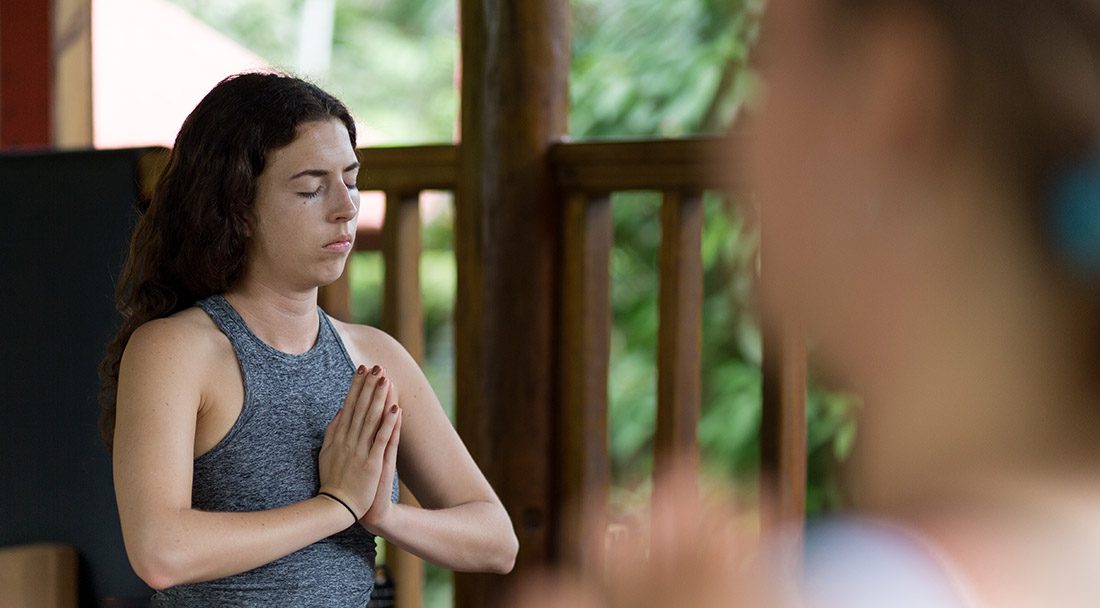
Physical and mental skills
- Physical fitness: There are many surf-inspired fitness routines you can do even while landlocked. Improving mobility will decrease any tweaking of the body.
- Swimming ability: Floating on your back and treading water are invaluable swimming skills and can be practiced in any pool.
- Mental fortitude: Yoga is a perfect activity to focus the mind and strengthen your determination when things get difficult. Surfing and yoga go so well together in fact, it’s precisely the reason we at Bodhi Surf + Yoga have built our signature vacation package to include an equal amount of each activity.
- Breathwork: Meditation or deep breathing techniques also go a long way when we need to hold our breath in the ocean. You can start each day with 10 deep breaths. Count to 5 on the inhale, and 5 on the exhale. This will also calm the mind.
Get Step-by-Step Surf Lessons in Your Inbox
Learn to Catch Waves with our free 5-day email series from one of our lead surf instructors here at Bodhi Surf + Yoga.
Change the heading on the Separator tab ->
Search
Get Step-by-Step Surf Lessons in Your Inbox
Learn to Catch Waves with our free 5-day email series from one of our lead surf instructors here at Bodhi Surf + Yoga.
Change the heading on the Separator tab ->
Most Read Blogs
What is the Meaning of Anjali Mudra?
May 27, 2020
Fitness for Surfers: Workouts, Exercises & Training
February 10, 2022
The Best Places to Eat in Uvita, Costa Rica
May 19, 2022
How to Get From SJO to Costa Ballena, Costa Rica
May 31, 2018
Change the heading on the Separator tab ->
Categories
Categories
- Bodysurfing (5)
- Food (6)
- Responsible Business (6)
- Surfing (59)
- Travel (62)
- Yoga (38)
Change the heading on the Separator tab ->
Newsletter
Thanks for subscribing! Please check your email for further instructions.
Change the heading on the Separator tab ->
Follow Us
Carly Stoenner
Change the heading on the Separator tab ->
Read more
A Typical Day: Bodhi Family Surf Camp
Words by George Frost
If you’re looking for a truly special bonding and connecting experience for your family, our Bodhi Family Surf Camp is the perfect vacation package for you! We’ll be using this blog to…
A Typical Day: Bodhi Awaken the Inner Surfer
Words by George Frost
What does a typical day here at Bodhi Surf + Yoga look like? Well, that depends on which of our vacation packages you choose. We have a number of different options, each…
How to Overcome Fear and Push Your Limits in the Lineup
Words by Allison Mouret
Every surfer, regardless of their level or abilities, will eventually encounter fear in the sport. This is actually a humbling observation because for everyone, fear can be understood and accepted as a…



